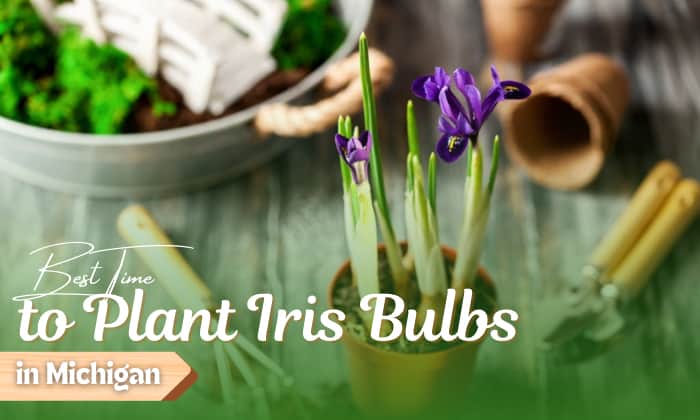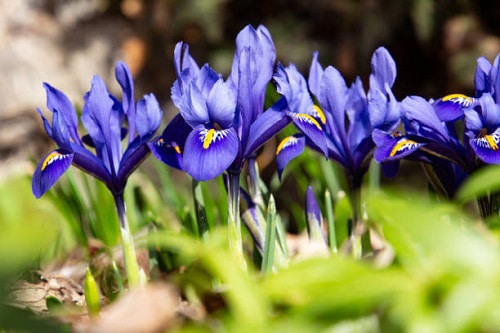Irises come in many colors, such as yellow, blue, white, and purple, making them popular among landscape designers and homeowners with flower meadows.
These plants are also hardy and straightforward to grow in Michigan, so long as you sow them in August and September when the weather is cool but not wintry.
Learn when to plant iris bulbs in Michigan and how to care for them below.
Table of Contents
Best Time to Plant Iris Bulbs in Michigan
Iris bulbs require cool temperatures to grow and establish themselves before winter. As a result, the best time of year to put them in the ground is early fall, when temperatures hover between 40 and 50℉.
In Michigan, people will grow irises in August and September so that their bulbs receive sufficient chilling hours before flowering in spring.
If you’re planning to do the same, keep in mind these tips:
- Sow bulbs six weeks before the first frost for the highest chances of success.
- Alternatively, you have until the first freeze date to plant iris flowers if you forgot to sow them earlier. The bulbs are resilient enough that they will still adapt and survive winter, though flowering time may come a bit later.
As for what month to put irises in the ground, September and October are usually the latest months for Michigan.
We recommend looking up your area’s first frost if you’re still wondering, “is it too late to garden now?” That said, you’ll find that in most cases, the recommendation above will apply.
| Location | Average first frost |
| Detroit | October 24 |
| Grand Rapids | October 5 |
| Warren | October 24 |
| Ann Arbor | October 4 |
| Lansing | October 6 |
| Dearborn | October 20 |
Iris bulbs planting time based on hardiness zones
Here are the planting dates for different hardiness zones in Michigan. We’ve calculated the dates based on the recommendations above.
| Hardiness region | Average first frost | Suggested planting dates |
| 4 | October 7 | August 26 – October 7 |
| 5 | October 21 | September 9 – October 21 |
| 6 | October 31 | September 19 – October 31 |
Tips for Growing Iris Bulbs Successfully in Michigan
1. Prepare the planting location
Find a well-draining spot with six hours of full sun or, at most, dappled light throughout the day. Sunlight isn’t only essential for photosynthesis but also keeps the ground from becoming soggy, which, in turn, prevents rot.
The soil must also be fertile, loamy, free of weeds and debris, and have a pH of 6 to 7. If planting irises on hard clay ground, dig two to four inches of compost into the top six inches of the soil.
Note that iris bulbs in pots should sit in potting soil, in receptacles six inches deep with drain holes and fine mesh at the bottom to keep the planting medium from falling out.
2. Plant iris bulbs at the right depth and care for them
Sow iris bulbs three times deeper than their heights. The planting holes should be three inches deep and twelve inches apart, with the bulbs’ small ends pointing upwards.
After sowing, backfill the holes, spread straw mulch around the base of the irises, and irrigate them with one inch of water per week.
Fertilize with a balanced N-P-K or a 5-10-5 formula in early spring and summer. Feed the irises one more time in autumn if they are winter-hardy where you live.
Dutch irises, for example, tolerate cold weather down to zone 5, so growers here should fertilize them three times a year.
3. Pick from the following varieties
Some iris varieties to grow in Michigan are:
- Sheila Ann
- Charming Billy
- Good Omen
- Eye Catcher
- George
What Are Some Common Pests for Irises?
Watch out for aphids, iris borers, and thrips. Aphids and thrips are removable with water sprays and insecticidal soap, while iris borers should be squashed by hand and eliminated using products containing spinosad or acephate.
Conclusion
When to plant iris bulbs in Michigan is a straightforward matter to consider. All you need to do is plant them six weeks before or up until the first frost. Then water them regularly and give the irises full sun to help them grow.
Just as importantly, remember not to prune the leaves before they die, or your plants may not flower next spring.
If you find this article helpful, please share it with other people.

Hi, I am William – Floridayards’ digital content creator. My job is to find answers to all your concerns with thorough research and our team’s expert advice. I will also bring you honest reviews on the best products and equipment for raising your beautiful garden. Please look forward to our work!















